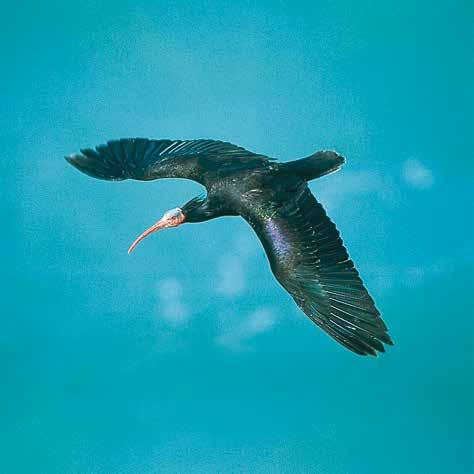
12 minute read
Migratory birds
Combating illegal killing, poisoning and electrocution: Protecting birds along the Adriatic Flyway
Geographical location in Europe Bird habitats along the Adriatic Flyway in Slovenia, Croatia, Bosnia-Herzegovina, Serbia, Montenegro, North Macedonia and Albania. The Adriatic Flyway stretches from north-eastern Europe through the Balkans down to Africa. Among the key areas are the Neretva Delta including the Hutovo Blato Nature Park in the border area of Croatia and Bosnia-Herzegovina and the Bojana Buna Delta including the Ulcinj Salina in the border area of Montenegro and Albania (Map p. 7, No. 2 and 3).
Advertisement
Status An international study conducted by BirdLife International in 2016 estimated that between 11 and 36 million birds per year may be killed or taken illegally in the Mediterranean region, and the situation has not become any less dramatic since then. Apart from Italy, Cyprus, Egypt and the Middle East, the Western Balkans are a hotspot of bird crime, with an estimated 600,000 to 1.6 million birds getting illegally killed per year. It is almost impossible for migratory birds to rest undisturbed in the region. In addition to illegal hunting and the increasing levels of habitat loss, the Balkan human population’s rising energy demand constitutes an additional threat to Europe’s birdlife. In recent years the development of wind farms and the electric grid have been driven forward in the region, thus also increasing the risk for birds of colliding with such installations and falling victim to electrocution or collision mortality.
Objectives Together with our large network of partners in conservation, our aim is to significantly reduce illegal bird hunting in the Balkans. To this end, we endeavour to establish a more accurate picture of the extent to which birds are illegally killed along the Adriatic Flyway, to draw the public’s attention to the significance of the problem, and to convince the national governments to consistently combat illegal hunting by means of suitable policies and statutory provisions. We hope to reduce bird deaths by electrocution at power lines by applying correction measures to existing installations while at the same time building up awareness for bird-friendly constructions to ensure that these will be used in future energy projects. Twice every year a major proportion of Europe‘s birds sets out on a long and dangerous journey. In their breeding, resting and overwintering areas we protect the nomads of the sky from illegal hunting as well as from increasing levels of habitat destruction.
The protection of migratory birds and their habitats in Europe has been a core concern of the EuroNatur Foundation since its establishment. We have been able to make a great deal of progress, for example by achieving a ban on bird hunting in Albania. As a result, the country has become a more attractive breeding and resting region for many migratory birds. Moreover, we have established a partner network in the countries sharing the Adriatic Flyway whose staff professionally collaborate and take joint action against bird hunting. Successes such as these strengthen our resolve. But there is still a lot of work ahead of us before the skies above the Balkans can truly be declared safe for our feathered globetrotters.
Selected activities in 2019 In Serbia, a special police task force was established that is charged with combating environmental crimes such as illegal bird hunting. In the course of numerous meetings and joint trainings, our Serbian partners at BPSSS have established a good relationship with the new police task force and closely collaborate with the officers.
In late 2019, three specimens of the endangered Northern Bald Ibis were shot in Croatia. Our Croatian partners at Biom turned this sad news into an opportunity to draw public attention to the issue of illegal bird hunting. The media exposure resulted in an increased awareness in the country of the issue of wildlife crimes.
In all the Western Balkan countries our partners have intensified their collaboration with the national electricity grid operators. This allowed for the insulation of some initial particularly dangerous powerlines.
Important successes in 2019 The Ulcinj Salina has finally been granted protection! As a result of the long-standing efforts by EuroNatur and many of its partners, the salina was declared a nature park in June 2019 and the following month it was designated as a Wetland of International Importance (Ramsar site) (please refer to p. 30 to 33).
As of March 1, 2019, Serbia has become the 79th Party to the African-Eurasian Migratory Waterbird Agreement (AEWA). Parties to this intergovernmental treaty commit to taking measures for the conservation of migratory water birds and their habitats. EuroNatur and its Serbian partner organisation BPSSS had long worked towards the country’s accession to the agreement. In Albania, the use of poisoned bait was made a punishable offence. Prior to this decision it had been legal to lay poisoned bait to control, for example, jackals. This insidious hunting method results in the death of large numbers of carrion-eating birds, such as vultures.
Outlook The close cooperation with local law enforcement has resulted in reduced levels of illegal hunting in many of our project areas. Our aim is to further promote this development in cooperation with the authorities. This also includes a scaled-up response to the laying of poisoned bait.
Partners: BirdLife International, VCF, IUCN Med, Tour du Valat, BPSSS, HDZZP, Biom, Naše ptice, CZIP, MSJA, PPNEA, AOS, DOPPS, MES, WWF Spain, WWF Greece, ATN
Funding: MAVA Foundation, Natum Foundation, EuroNatur’s donors and sponsors
Wolf, bear & lynx
Getting safely across motorways: Green bridges for wolves
Status Wolves are re-expanding their range in Europe. However, intensifying land use and the expansion of the road network result in the increasing fragmentation of the wolves’ habitats. Due to their central location in Europe, Poland and Slovakia are natural transit areas for goods transports. This gives rise to the intensive development of motorways and dual carriageways. Given that wolves travel great distances in their search for food and new territories, it is unavoidable that they encounter busy roads which often become lethal barriers.
Objectives We create wildlife corridors between areas of ecological importance and thus contribute to the further expansion of wolf populations in eastern central Europe. In order to minimise the risk of traffic accidents and to avoid the isolation of populations we are driving forward the construction of wildlife crossings (including vegetated overpasses) for wolves and other wildlife. Europe‘s large carnivores are under pressure. We are laying the groundwork to ensure that brown bears, wolves and lynx can once again expand their range, and our educational work is aimed at gaining the necessary acceptance in the population at large.

Selected activities in 2019 In Slovakia, our project partners at CWS have started to analyse traffic on a number of the countries’ dual carriageways. Using the resultant data they were able to identify segments that are highly frequented by wildlife and have submitted initial recommendations for wildlife crossings to the competent authorities. In Poland, our partners from the ecological organisation „ Workshop for all Beings“ have critically monitored and advised on construction work on several roads. Additionally they have started an information campaign on migration corridors for large mammals in Poland.
Important achievements in 2019 „ Workshop for all Beings“ has forged new alliances with other conservation organisations and with the Technical University of Lubin. It is very important to have a broad civil society alliance given that constructive cooperation with public authorities in Poland tends to be difficult.
In Slovakia, our partners successfully captured several wolves and fitted them with GPS transmitters. The resultant data give important insights into the wolves’ behaviour in areas with heavy road traffic.

Outlook The density of wildlife crossings in Slovakia is still extremely low. We will work to ensure that political decision-makers address this gap. In Poland, we will critically monitor the planned road development projects and will notify potential issues to the European Commission.
Partners: CWS, „ Workshop for all Beings“, Wilk
Funding: Elisabeth Seifert-Becker’s endowment fund for the protection of wolves in memory of Viktoria Neumann, Emilie and Franz Seifert, EuroNatur’s donors and sponsors
Wolf, bear & lynx
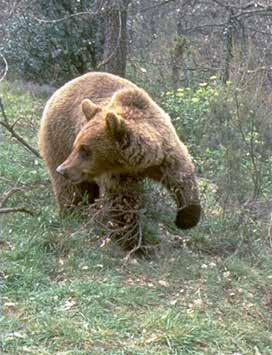
Geographical location in Europe The Dinaric-Pindos brown bear population extends across eight countries from Slovenia to Greece. During the reporting year, our work focused on BosniaHerzegovina and Montenegro (Map p. 7, No. 8).
Status In addition to Scandinavia and the Carpathian arc, the Western Balkans is the most important brown bear range in Europe. It is however unclear exactly how many members of the Ursus arctos actually still roam through the Dinaric forests. There are significant knowledge gaps especially when it comes to Montenegro and Bosnia-Herzegovina. There is a lack of systematic population surveillance as well as a lack of management plans for the bear population, both of which are needed in order to defuse potential conflicts and to ensure peaceful coexistence of bears and humans.
Objectives Together with our partners in Montenegro and Bosnia we are aiming to find out exactly how many brown bears do indeed still live in the Dinarides and determine the measures needed in order to protect the bear population in the two countries. In addition, we advocate for acceptance for the bears’ return among the governments, hunting associations and the population at large.
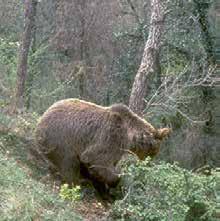
Selected activities in 2019 In Montenegro, a bear task force has been in operation since the spring of 2019. The experts intervene when there are signs of potential conflict between bears and humans or when a bear is in danger. In November 2019, the first training unit was delivered for the Montenegrin bear protectors under the aegis of our experienced Croatian partners.
A trainee programme for the protection of large carnivores, the “Large Carnivore Field School” was conducted in Bosnia-Herzegovina. During the one-week seminar in August the 15 participants studied, for example, how peaceful coexistence between bears and humans can be achieved or how a tranquilizer gun is correctly used. Tranquilizer guns are required when a bear needs to be approached for scientific purposes or when a bear must be rescued from a hazardous situation.
Important achievements in 2019 The “Large Carnivore Field School” has for the first time highlighted the country’s potential: There are many young people in BosniaHerzegovina who are interested in nature conservation and wish to contribute to the large carnivores’ long-term protection as well as to facilitating the coexistence between humans and animals.
For the participants, the bear task force’s first training session in Montenegro was an important exercise for “emergencies”. Being equipped with a tranquilizer gun means that the team has now achieved operational readiness.

Outlook In both countries it is now important to complete the management plans and to introduce the bear task forces to the wider public so that the local people are aware of who to turn to in case of conflicts arising with bears. As a next step following the successful Field School we now plan to give junior researchers in Bosnia-Herzegovina the opportunity to develop and implement their own projects with regard to large carnivores. Next year we will also transfer the Field School concept to Montenegro.
Partners: CZIP, CZZS
Funding: Bernd Thies Foundation, EuroNatur’s donors and sponsors
Wolf, bear & lynx
Fresh blood for endangered lynx
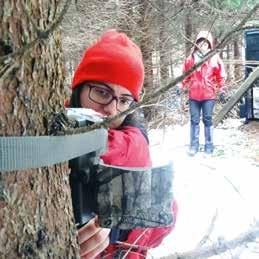
Geographical location in Europe Source population in Carpathians (Romania, Slovakia) (Map p. 7, No. 6 and 7). Release region in Dinarides (Croatia, Slovenia, Italy) (Map p. 7, No. 8).
Status Without international cooperation there would no longer be any lynx in the north-western Balkan Peninsula. Carpathian individuals of this rare felid were first released in Slovenia in 1973. However, the populations stayed small, isolated and genetically impoverished. Lynx in the Dinarides are at risk of extinction.
Objectives The “LIFE Lynx” project is funded by the European Union and supported by EuroNatur. Its aim is to augment the gene pool of the Dinaric lynx population and to bring the isolated population into contact with other lynx populations, especially with lynx in the Alps.
More information, photos and videos at www.lifelynx.eu, www.facebook.com/LIFELynx.eu
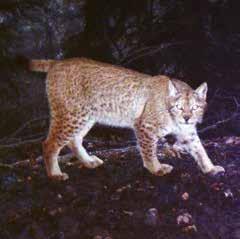
Selected activities in 2019 Camera traps and genetic research are indispensable when it comes to getting an overview of the exact number of lynx and their ranges in the Dinarides mountain regions which are difficult to access in parts. In 2019, a total of 107 camera traps yielded photographs of lynx; hair traps, the analysis of tracks in the snow, and investigations of prey killed by lynx yielded DNA samples for analysis.
Our partners have put a lot of commitment into PR work. Pupils in 16 educational establishments in the release region have studied this felid species. The first part of the documentary entitled “Path of the lynx” was screened at a festival and was received with great enthusiasm. Regular updates are posted to both the project website (www.lifelynx.eu) and on social media.
Important achievements in 2019 In February 2019, the first two lynx from the Carpathian Mountains were released in Slovenia and Croatia respectively. The males Doru and Goru have already occupied territories in their new homes. Goru has even produced offspring already with a local female lynx.
The involvement in the project of local hunters in Slovenia and Croatia has succeeded very well. With their expertise and local knowledge, hunters are important allies in ensuring the success of the re-introductions. Moreover, the Slovenian hunting association trained 20 police officers in how to deal with instances of illegal hunting of lynx.

Outlook More lynx releases in the Dinarides are planned. Monitoring is to be continued both in the Dinarides and in the Carpathians with the aim of assessing the success or otherwise of the re-introductions and also in order to ensure that the source population is not adversely impacted.
Partners: University of Zagreb, Slovenia Forest Service, Hunters Association of Slovenia, Institute of the Republic of Slovenia for Nature Conservation, Technical University in Zvolen, University of Ljubljana, Association Progetto Lince Italia, Karlovac University, Biom, ACDB, Italian Carabinieri special command unit for the protection of forests, the environment, and the agri-food sector
Funding: EU LIFE, EuroNatur‘s donors and sponsors, and others







